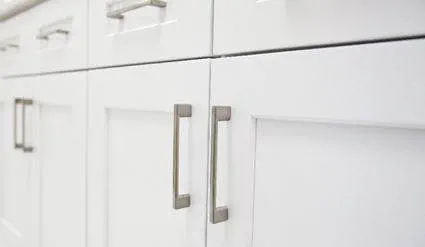
The Glue Talk Blog

Thermofoil cabinet doors are becoming popular in many of today’s kitchens. These vinyl-faced doors are available in a variety of styles and colors, easy to clean, and seamless. Commonly assembled with medium-density fiberboard (MDF) cores, Thermofoil vinyl-faced doors are more stable, have a lower tendency to bow or crack, and usually cost less than solid wood. Since Thermofoil laminate adhesive cabinets also have superior moisture resistance, they are often installed in kitchens and bathrooms.
There are some challenges with vinyl-faced cabinet doors, and we can help. These PVC coated cabinet doors typically do not hold up when exposed to high heat. High temperatures cause the vinyl to pull away from the MDF core without a laminating adhesive or coating. As a result, manufacturers generally have very strict production specifications that cabinet fabricators and suppliers need to follow when designing, building, selling, and installing Thermofoil cabinetry. Common heat sources that can compromise PVC doors include deep-oil fryers, self-cleaning ovens, gas-top stoves, steam producing appliances, crock pots, and toaster ovens.
H.B. Fuller’s swift®tak 4431 and swift®hardener 9759 help solve this problem for cabinet door manufacturers. This two-component waterborne polyurethane adhesive for membrane pressing offers a significant improvement in heat resistance compared to other membrane pressing adhesives currently in the market. Our team of technical experts will partner with you to ensure application of this latest adhesive provides a quality and compliant, yet cost-effective membrane pressing solution.
Contact us to learn more about how we can help increase the heat resistance in vinyl-faced and PVC coated cabinets.
Blog Categories
Blog Categories
Archive
- 2024
- 2023
-
2022
- February (4)
- March (3)
- April (1)
- May (2)
- June (5)
-
August (6)
- Beverage Labeling Market In Africa: A Huge Potenial
- H.B. Fuller’s Glue House: Scavenger Hunt
- Increasing Global Aging Population: Impacts and Challenges
- Innovations and Key Challenges in Sustainable Disposable Absorbent Hygiene Products
- Supporting Racial Equity in Our Community
- Top 5 Reasons to Invest in H.B. Fuller
- September (4)
- November (2)
- December (2)
-
2021
- January (3)
-
February (7)
- Celebrating Exceptional Service During COVID-19 Complications
- Cyanoacrylates: What They Are and What They Do
- Innovative two-shot bookbinding adhesive
- Make a Difference 2020
- Problem Solving: Paper straws in drinking beverages
- Stronger straws
- Substances of Interest in Disposable Absorbent Hygiene Products
- March (4)
- April (4)
- May (4)
- June (5)
- July (2)
- August (5)
- September (2)
- October (1)
- November (3)
- December (2)
-
2020
- January (4)
- February (2)
- March (3)
- April (4)
- May (3)
-
June (7)
- Community Support in the Era of Coronavirus
- Employee Creates Face Shields with 3D Printer
- Improved Packaging Integrity and Greater Customer Satisfaction
- Liquid-Resistant Paper Straws
- What is a Sealant
- What Is the Future of Commercial Disinfectants
- Winning over consumers with e-commerce packaging solutions
-
July (6)
- Employees Take Action to be Part of Healing and Growth
- Gain a competitive advantage with packaging adhesive solutions
- HB Fuller Company Foundations Commitment to Communities
- Packaging Solutions for the South African Agriculture Market
- Supporting Organizations That Provide STEM Education for Youth
- Where Does Sustainability Stand Amid COVID-19
- August (3)
- September (2)
- October (4)
- November (2)
- December (4)
